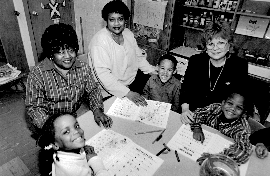|
|
Fostering Meaningful Education PartnershipsFocus: National Network program brings schools, parents and community together to help students
Christine A. Rowett |

While attending a recent education workshop in Washington, D.C., Paula Williams met a mother who wanted to be more involved in her children's schools. The mother was frustrated, Williams recalls, by the lack of opportunities for parents who work during the day but want to offer their support for education. Paula Williams had some answers.
Williams is one of six area facilitators for School, Family and Community Partnerships in the Baltimore City Public Schools, part of the National Network of Partnership Schools developed at the Hopkins Center on School, Family and Community Partnerships. She helps about 30 elementary, middle and high schools develop programs and practices that enable parents, educators and community and business partners to work together to help more students succeed in school.
"Everyone has a responsibility for quality education," says the center's director, Joyce L. Epstein. "The National Network of Partnership Schools helps schools take the responsibility for creating and maintaining programs that involve families and communities in ways that are tailored to each school site."

As director of the Hopkins Center on School, Family and Community Partnerships, Joyce L. Epstein oversees a program encompassing more than 750 schools, more than 60 school districts and eight states. "Everyone has a responsibility for quality education,"she says. |
Hopkins researchers used more than 15 years of studies in elementary, middle and high schools to develop a framework for successful partnerships. It is based on six types of involvement: parenting, communicating, volunteering, learning at home, decision making and collaborating with the community.
Each school starts with an Action Team for Partnerships, which consists of teachers, parents, administrators and others. The team writes an annual Action Plan that includes practices from the six types of involvement selected to meet the school's improvement goals.
"There are hundreds of practices of partnership to choose from for the six types of involvement," Epstein explains. "Schools need to meet explicit challenges to involve all families, not just those who are easiest to reach. Also, each type of involvement leads to different results for students, families and the school, so schools must plan well to reach specific goals."
Some schools host Family Fun and Learning nights designed to create an informal learning atmosphere for both students and their parents. Along with dinner and some fun, school subjects or new tests are sometimes explained and experienced.
"Many parents are intimidated when they first come to the school," says Paula Williams. "At an event like that, parents and teachers can learn to respect each other by interacting." Williams has seen the number of people working together grow considerably in the last few years; in her area of the southern district, more than 5,000 families have participated in Family Fun and Learning nights. Hundreds more volunteer their time in schools and classrooms.

Paula Williams, second from left, is one of six area facilitators. Here, she works with Anne Arundel Elementary teacher Joyce Johnston, left, principal Lydia Lafferty and a group of kindergarten students. Williams helps 30 schools develop their own partnership programs. |
"When I started out, let's face it, we hardly saw parents in the building," Williams says. "Now the concept of parental involvement has changed because parents can become involved in many different ways at home and at school."
Schools, districts and state departments of education are invited to join the National Network of Partnership Schools. There are no membership fees, but schools must agree to some requirements. The center provides a handbook, written by Epstein and her colleagues, annual training workshops, newsletters, research opportunities and assistance by phone, e-mail or the Web.
"This is not a canned or prescriptive program," Epstein says, "but members of the Network must agree to use the common framework of six types of involvement and the Action Team structures. District and state members must have adequate staff and budgets to assist their schools and support their programs of partnership. The common approaches ensure that members will make progress and be able to share best practices or solve problems with each other."
The rewards far outweigh any costs, Williams says. "When these children finish school, they will become members of their community. We need to make sure they're prepared. We're helping them to be better citizens.
"We're still changing attitudes," she adds. "We still have some parents, teachers and administrators who don't work well together. But it's a learning process, and it's worth it because of the kids."
The National Network for Partnership Schools at Hopkins was initiated after years of support for research from the U.S. Department of Education/OERI, and field work conducted in collaboration with the Fund for Educational Excellence and with hundreds of educators and parents in Baltimore City Public Schools. Now, the National Network includes more than 750 schools, more than 60 districts, and eight states, all working to implement better programs of partnerships.
A recent grant from the DeWitt Wallace-Reader's Digest Fund will allow the center to maintain the National Network of Partnership Schools and expand to even more schools, districts and states. The three-year, $900,000 grant will enable the center to help educators develop closer connections and build stronger relationships with families and communities.
The new project will focus primarily on Title I sites, which are federally mandated to involve low-income families in the education of their children. Researchers and educators in Baltimore and across the country will work together to develop tools to improve the coordination of Title I and the National Network of Partnership Schools.
Support for the project is an extension of the DeWitt Wallace-Reader's Digest Fund's ongoing efforts to help parents overcome barriers that prevent them from becoming more involved in helping their children succeed in school.
"Schools need to take steps to show that they are interested in having parents as partners," says M. Christine DeVita, president of the fund. Building closer relationships of schools, families and communities, she says, is a key component of the fund's mission to improve the quality of educational and career development opportunities, and to increase access to those services in low-income areas.
For more information, check the National Network's Web site at www.csos.jhu.edu/p2000/.
| GO TO MARCH 9, 1998 TABLE OF CONTENTS. |
| GO TO THE GAZETTE HOMEPAGE. |